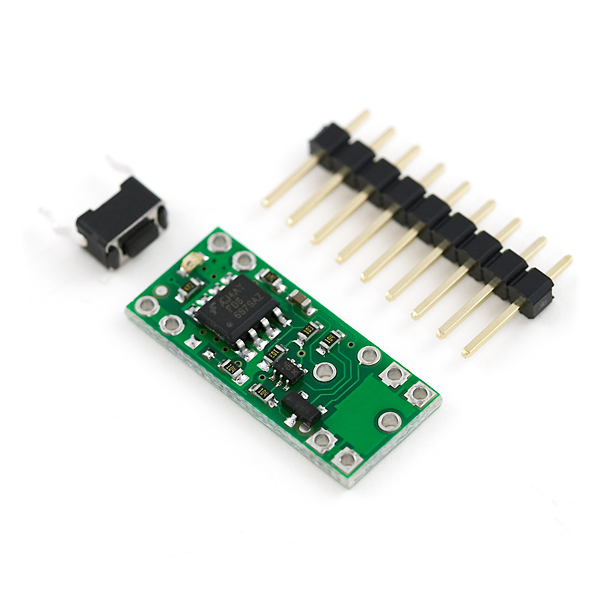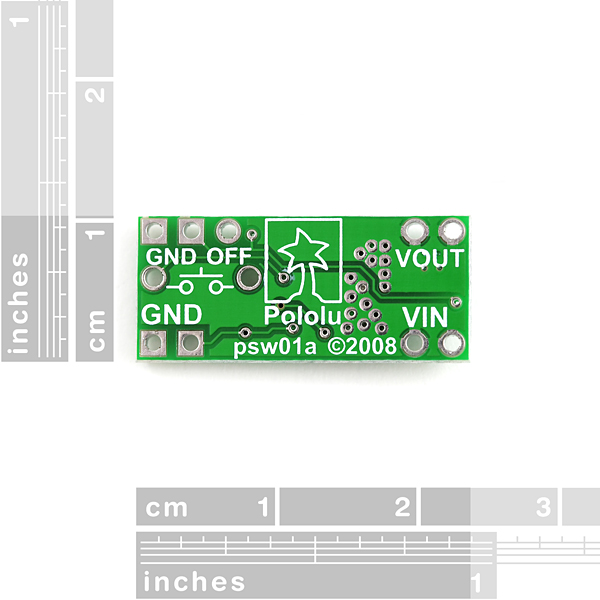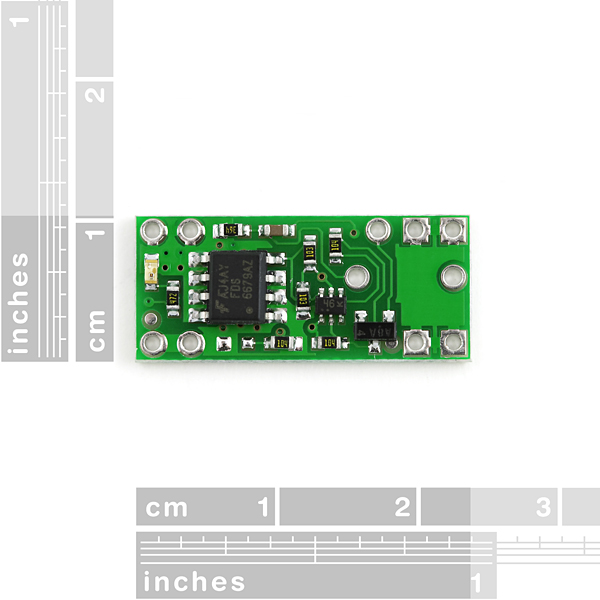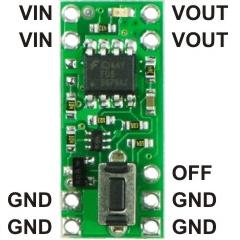Pushbutton Power Switch SV
The Pololu Pushbutton Power Switch is a compact, solid-state power switch controlled by a momentary pushbutton switch. Because the switched current does not flow through the mechanical switch, a large variety of small, low-power switches can be used to control a substantial amount of power. The use of momentary pushbutton switches also allows multiple switches to be used in parallel to control the power to one load. The solid-state switch also allows the load to turn off its own power, which can be beneficial when used with battery chemistries sensitive to over-discharging. Please note that this switch has several drawbacks when compared to mechanical switches, so please be sure you fully understand this product before using it in your system.
The Pololu Pushbutton Power Switch can fit in an 18-pin DIP (dual in-line package) footprint, making it compatible with solderless breadboards and perforated printed circuit boards with standard 0.1" spacing. For such applications, the included male header pins can be soldered to the switch PCB as shown in the picture to the right. Alternatively, wires can be soldered directly to the switch PCB for non-breadboard applications. For high-current applications, make sure that the wires can safely carry the current. Two pads/pins are provided for each of the power nodes, and multiple pads should be used for applications drawing over 5 A.
The included pushbutton switch can be used to trigger the switch. Alternatively, a separate pushbutton, such as a remote panel-mounted unit, can be used instead. Multiple pushbuttons can be wired in parallel for multiple control points, and each of the parallel pushbuttons will be able to turn the switch on or off. The latching circuit performs some button debouncing, but pushbuttons with excessive bouncing (several ms) might not function well with this product.Comes with a pushbutton and 9-pin header not installed.
- 4.5-20VDC operating voltage
- 10A maximum current
- Draws very little current in off state, typically under 0.01uA
- 0.4x0.9x0.125"
Pushbutton Power Switch SV Product Help and Resources
Core Skill: Soldering
This skill defines how difficult the soldering is on a particular product. It might be a couple simple solder joints, or require special reflow tools.
Skill Level: Noob - Some basic soldering is required, but it is limited to a just a few pins, basic through-hole soldering, and couple (if any) polarized components. A basic soldering iron is all you should need.
See all skill levels
Core Skill: Robotics
This skill concerns mechanical and robotics knowledge. You may need to know how mechanical parts interact, how motors work, or how to use motor drivers and controllers.
Skill Level: Noob - You will be required to put together a robotics kit. Necessary parts are included and steps will be easy to follow. You also might encounter basic robotics components like bearings, mounts, or other hardware and need a general idea of how it goes together.
See all skill levels
Core Skill: Programming
If a board needs code or communicates somehow, you're going to need to know how to program or interface with it. The programming skill is all about communication and code.
Skill Level: Rookie - You will need a better fundamental understand of what code is, and how it works. You will be using beginner-level software and development tools like Arduino. You will be dealing directly with code, but numerous examples and libraries are available. Sensors or shields will communicate with serial or TTL.
See all skill levels
Core Skill: Electrical Prototyping
If it requires power, you need to know how much, what all the pins do, and how to hook it up. You may need to reference datasheets, schematics, and know the ins and outs of electronics.
Skill Level: Rookie - You may be required to know a bit more about the component, such as orientation, or how to hook it up, in addition to power requirements. You will need to understand polarized components.
See all skill levels
Comments
Looking for answers to technical questions?
We welcome your comments and suggestions below. However, if you are looking for solutions to technical questions please see our Technical Assistance page.
Customer Reviews
5 out of 5
Based on 1 ratings:
Great product
Received part on time and it is a good quality part.





A fun project made possible in part by this pushbutton power switch:
http://arduiniana.org/projects/the-reverse-geo-cache-puzzle/
So, I am not clear on one thing. Once power has been turned on, does pushing the switch again turn power off or do you have to pulse the OFF pin to kill the power?
In case anyone else is wondering, you can do either- press the switch again to unlatch, or pulse the OFF pin. The idea behind the OFF pin is that the device can turn itself off, but it is not mandatory.
I like that tiny little push button they use. Anyone know where you can get just the button?
I don't know the exact part # used, but you can find tons of them at the usual suppliers - look for 'tactile switch', 'through hole', 'rectangular' or 'rectangular button'. The former should yield plenty of results. If using a generic search engine, add something like "add to cart" to the query to limit results to stores (that will also filter out some stores that use different terminology, but mostly you'll be filtering out blogs, information pages, etc.)
For everyone who was looking for more information (and usage instructions) for this product, here's a link to the designer's website: http://www.pololu.com/catalog/product/750
Just mated this with a 22mm piezo pushbutton from schurter. Initially I had some problems going from the ON state to the OFF state, but I added a 2.2k resistor in parallel with a .1u cap from Vin to the outer push button contact and got it to work pretty well. Using it with a DPDT relay to control a linear actuator for an automated cabinet.
Hello
What is the allowed voltage range for the "OFF" input? Would 3.3V - 5V do? Is this active high or low?
From the Pololu product page for this switch:
"Applying more than approximately 1 V to the OFF pin will cause the power switch to turn off. The maximum voltage for the OFF pin is 30 V independent of the switch voltage (VIN)."
Maybe Sparkfun can add this to their product description of both SV and LV switch versions?
Thanks for the link to your project. As cool as the whole GPS box saga has been, the tidbit that was most useful was noting how the OFF pin works. Being Aerospace and not EE (and hence looking at the components and traces wasn't going to give me any hints) it was nice that you spelled out the following in plain english:
"When the sketch decides it?s time to shut down ... it simply brings the Pololu?s power control pin high, cutting power."
Not that with some tinkering I couldn't have figured things out, but now I know. Cheers mate!